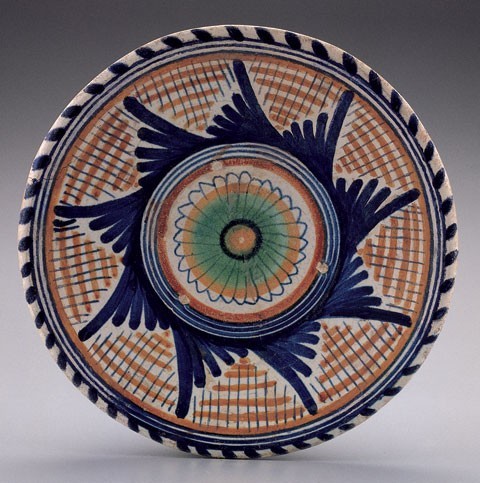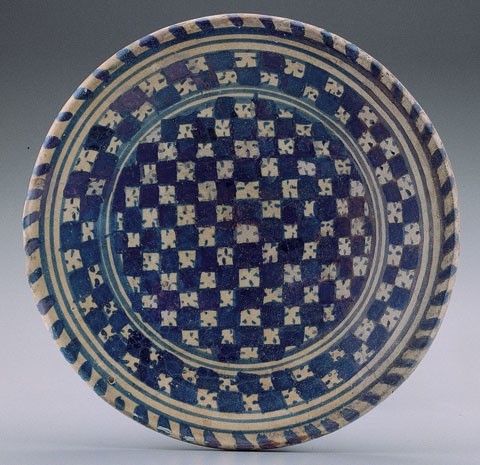
Dish, polychrome majolica, Netherlandish, 1620–40. Tin-glazed earthenware with lead glaze on back. D. 10". (Private collection; photo, Gavin Ashworth.)

Dish, blue-painted majolica, Netherlandish, 1610–30. Tin-glazed earthenware with lead glaze on back. D. 8". (Private collection; photo, Gavin Ashworth.)
During the winter of 1970/71 in Albany, New York, the 1624 Dutch fortress, Fort Orange, was partially excavated under the direction of New York state archaeologist Paul R. Huey. The excavation was a salvage project; installation of pylons for a new bridge over the Hudson was planned for the spring of 1971.
Families of Indian traders had lived in the fort, and hundreds of tin-glazed earthenware sherds from their households were recovered. As a collector of Dutch delft, I examined these artifacts and noticed that, in addition to delft sherds whose surfaces were entirely covered by a tin glaze, there were also fragments with a tin glaze only on the obverse side and a transparent lead glaze over a clay slip on the reverse. Paul Huey had noticed this earlier, forewarned to watch for their occurrence by Ivor Noël Hume, the former director of the Department of Archaeology of the Colonial Williamsburg Foundation in Virginia.
I had read about majolica from Antwerp that was entirely tin glazed and of museum quality. These Fort Orange sherds, however, were cruder in design and potting. We needed more information for identification, but found the printed word a language barrier; so I volunteered to travel to the Netherlands and consult Dutch experts.
In Amsterdam, the Dutch ceramics department at the Rijksmuseum was closed for renovations and its director was on leave. Therefore, I went first to the Boymans–van Beuningen Museum in Rotterdam. The curator who met me instantly understood my quandary. She explained that the Fort Orange sherds which were tin glazed on only one side are Dutch majolica (“j” pronounced as “y”), an earthenware forerunner of delft introduced into the Netherlands around 1550 by the first or second generation Italian potters of Antwerp. Cost-conscious Dutch potters immediately began to copy the majolica, but because tin was rare and expensive, they limited the tin glaze to the front surface. About 1600, Chinese porcelain was imported into Holland and became extremely popular. Dutch potters also copied porcelain forms and decoration, and by about 1660 majolica ceased to be made, except in Friesland. The two earthenware forms are now considered distinct from each other; the majolica has an Italian design tradition (except for one stylized Chinese Wan-li pattern) whereas the delft follows the blue-and-white Chinese decorative style.
The museum’s curator and I next proceeded to a large room with tiers of wide, shallow drawers holding sherds. Pointing out the drawers with early-seventeenth-century majolica, she left me alone to study them—perched on a ladder six feet above the floor. Unlike the plow-zone sherds commonly found in North America, these fragments, retrieved from such locations as canal beds or construction sites, were roughly five or six inches square with colorful decorations. The most poignant, however, were those recovered from earth churned up by Germany’s terrible World War II bombings of Rotterdam. The sherds exactly duplicated the patterns of those from Fort Orange.
Before returning to the United States, I visited four other museums and talked with the city archaeologist of Amsterdam and with a prominent majolica collector. From my research, I gained priceless insights about Dutch ceramics. This information was particularly valuable in explaining this delft dichotomy to American archaeologists who, in turn, would determine ethnic influences and chronology.
Since my trip, a number of books and articles on Dutch majolica have been published. Some have English texts or, if Dutch, English summaries. And at least one is bilingual throughout.
Charlotte Wilcoxen
Author of Dutch Trade and Ceramics in America in the Seventeenth Century, published in 1987 by the Albany Institute of History & Art (Albany, New York), Charlotte Wilcoxen continues to be actively involved in ceramic research at the age of ninety-five.
SELECT ANNOTATED BIBLIOGRAPHY
Huey, Paul R. “Aspects of Continuity and Change in Colonial Dutch Material Culture at Fort Orange, 1624–1664.” Ph.D. diss., University of Michigan, 1988.
Korf, Dingeman. Nederlandse majolica. Haarlem: DeHaan, 1981. In Dutch. This book has several hundred illustrations, and with the aid of a Dutch dictionary, the captions are easy to read.
Scholten, Frits. The Edwin van Drecht Collection of Dutch Majolica and Delftware. Amsterdam: E. van Drecht, 1993. Bilingual, Dutch and English. A fine and unusual book, this reference has scores of color illustrations and short captions.
Van Dam, J. D. “Geleyersgoet en Hollants porceleyn: Ontwikkelingen in de Nederlandse aardewerk-industrie, 1560–1660.” Medelingenblad, Nederlandse, vereniging van vriended van de ceramiek 108 (1982): 13–88. In Dutch with an English summary. Occupying the entire issue of this serial publication, this article includes scores of illustrations covering both delft (faïence) and majolica plates.
Wilcoxen, Charlotte. “Dutch Majolica of the Seventeenth Century.”American Ceramic Circle Bulletin, no. 3 (1982): 17–28.
———. Dutch Trade and Ceramics in America in the Seventeenth Century. Albany: Lane Press of Albany, 1987.
